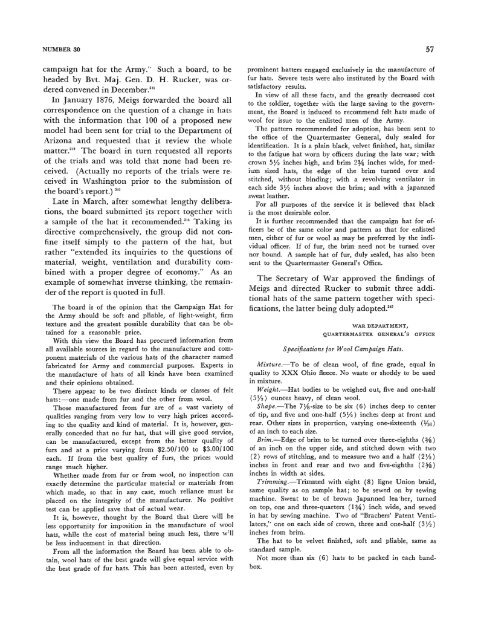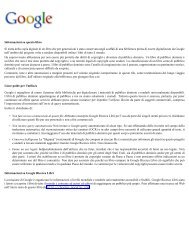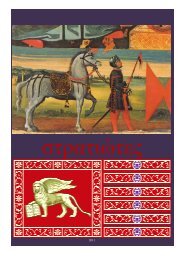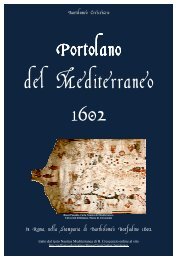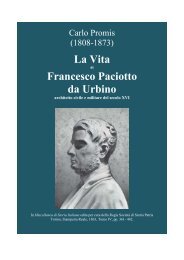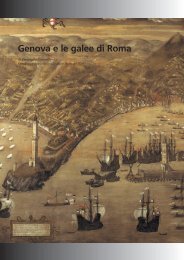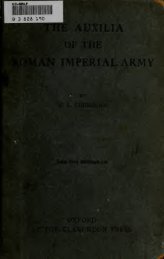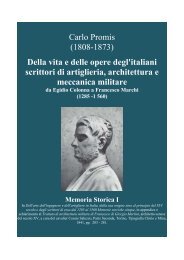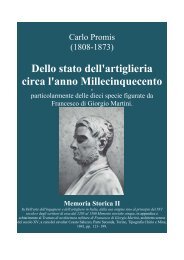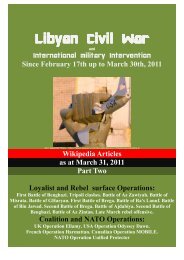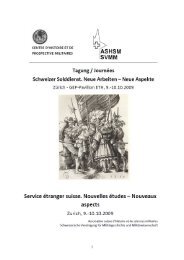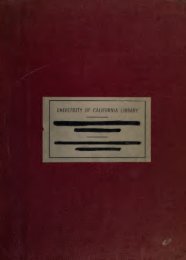United States Army Headgear 1855-1902 - Libreria Militare Ares
United States Army Headgear 1855-1902 - Libreria Militare Ares
United States Army Headgear 1855-1902 - Libreria Militare Ares
- No tags were found...
Create successful ePaper yourself
Turn your PDF publications into a flip-book with our unique Google optimized e-Paper software.
NUMBER 30 57campaign hat for the <strong>Army</strong>." Such a board, to beheaded by Bvt. Maj. Gen. D. H. Rucker, was orderedconvened in December.'"In January 1876, Meigs forwarded the board allcorrespondence on the question of a change in hatswith the information that 100 of a proposed newmodel had been sent for trial to the Department ofArizona and requested that it review the wholematter.'" The board in turn requested all reportsof the trials and was told that none had been received.(Actually no reports of the trials were receivedin Washington prior to the submission ofthe board's report.)'"Late in March, after somewhat lengthy deliberations,the board submitted its report together witha sample of the hat it recommended.'" Taking itsdirective comprehensively, the group did not confineitself simply to the pattern of the hat, butrather "extended its inquiries to the questions ofmaterial, weight, ventilation and durability combinedwith a proper degree of economy." As anexample of somewhat inverse thinking, the remainderof the report is quoted in full.The board is of the opinion that the Campaign Hat forthe <strong>Army</strong> should be soft and pliable, of light-weight, firmtexture and the greatest possible durability that can be obtainedfor a reasonable price.With this view the Board has procured information fromall available sources in regard to the manufacture and componentmaterials of the various hats of the character namedfabricated for <strong>Army</strong> and commercial purposes. Experts inthe manufacture of hats of all kinds have been examinedand their opinions obtained.There appear to be two distinct kinds or classes of felthats:—one made from fur and the other from wool.Those manufactured from fur are of it vast variety ofqualities ranging from very low to very high prices accordingto the quality and kind of material. It is, however, generallyconceded that no fur hat, that will give good service,can be manufactured, except from the better quality offurs and at a price varying from $2.50/100 to $3.00/100each. If from the best quality of furs, the prices wouldrange much higher.Whether made from fur or from wool, no inspection canexactly determine the particular material or materials fromwhich made, so that in any case, much reliance must beplaced on the integrity of the manufacturer. No positivetest can be applied save that of actual wear.It is, however, thought by the Board that there will beless opportunity for imposition in the manufacture of woo]hats, while the cost of material being much less, there w'llbe less inducement in that direction.From all the information the Board has been able to obtain,wool hats of the best grade will give equal service withthe best grade of fur hats. This has been attested, even byprominent hatters engaged exclusively in the manufacture offur hats. Severe tests were also instituted by the Board withsatisfactory results.In view of all these facts, and the greatly decreased costto the soldier, together with the large saving to the government,the Board is induced to recommend felt hats made ofwool for issue to the enlisted men of the <strong>Army</strong>.The pattern recommended for adoption, has been sent tothe office of the Quartermaster General, duly sealed foridentification. It is a plain black, velvet finished, hat, similarto the fatigue hat worn by officers during the late war; withcrown 5/2 inches high, and brim 2% inches wide, for mediumsized hats, the edge of the brim turned over andstitched, without binding; with a revolving ventilator ineach side 3/2 inches above the brim; and with a japannedsweat leather.For all purposes of the service it is believed that blackis the most desirable color.It is further recommended that the campaign hat for officersbe of the same color and pattern as that for enlistedmen, either of fur or wool as may be preferred by the individualofficer. If of fur, the brim need not be turned overnor bound. A sample hat of fur, duly sealed, has also beensent to the Quartermaster General's Office.The Secretary of War approved the findings ofMeigs and directed Rucker to submit three additionalhats of the same pattern together with specifications,the latter being duly adopted.'"WAR DEPARTMENT,QUARTERMASTER GENERAL'S OFFICESpecifications for Wool CampaignHats.Mixture.—To be of clean wool, of fine grade, equal inquality to XXX Ohio fleece. No waste or shoddy to be usedin mixture.Weight.—Hat bodies to be weighed out, five and one-half(5 /2 ) ounces heavy, of clean wool.Shape.—The 7J^-size to be six (6) inches deep to centerof tip, and five and one-half (55/2) inches deep at front andrear. Other sizes in proportion, varying one-sixteenth (Vie)of an inch to each size.Brim.—Edge of brim to be turned over three-eighths (Ys)of an inch on the upper side, and stitched down with two(2) rows of stitching, and to measure two and a half (2 Va)inches in front and rear and two and five-eighths (2^)inches in width at sides.Trimming.—Trimmed with eight (8) ligne Union braid,same quality as on sample hat; to be sewed on by sewingmachine. Sweat to be of brown Japanned lea her, turnedon top, one and three-quarters (1 ^) inch wide, and sewedin hat by sewing machine. Two of "Brachers' Patent Ventilators,"one on each side of crown, three and one-half (3^2)inches from brim.The hat to be velvet finished, soft and pliable, same asstandard sample.Not more than six (6) hats to be packed in each bandbox.


